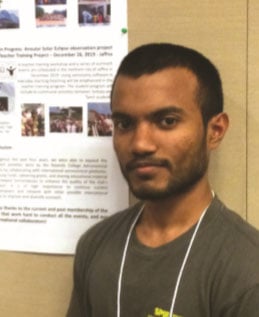POLINA POTOCHEVSKA, EDITORIAL INTERN
 To a novice in optics or photonics, the idea of manipulating light may seem trivial. But from the perspective of Ashan Ariyawansa, a fifth-year doctoral student at the University of Rochester, the complexities of polarization and orbital angular momentum inspire awe. “It amazes me how much there is to be discovered in light more than 150 years after [James Clerk] Maxwell formulated his electromagnetic theory,” he said in an interview with Photonics Media.
To a novice in optics or photonics, the idea of manipulating light may seem trivial. But from the perspective of Ashan Ariyawansa, a fifth-year doctoral student at the University of Rochester, the complexities of polarization and orbital angular momentum inspire awe. “It amazes me how much there is to be discovered in light more than 150 years after [James Clerk] Maxwell formulated his electromagnetic theory,” he said in an interview with Photonics Media.
During his undergraduate career, Ariyawansa was interested in becoming an astronomer. While participating in a summer research program at the Mount Wilson Observatory in California, he discovered the Center for High Angular Resolution Astronomy (CHARA) array — an optical interferometer array of six telescopes that is capable of capturing details down to 200 microarcseconds. Ariyawansa said he was “blown away by the awesomeness of optics and optical engineering.” When the program ended, he decided to shift his career focus, changing his physics major to one in optics.
The transition was mostly smooth. One challenge he faced was in gaining an intuitive understanding of geometrical optics. “However, in the second year, I took a lens design course and I really enjoyed it,” he said. “Since it used CODE V assignments and I was able to visualize many properties of the optical systems we designed, it cleared many mysteries in the aberration theory for me.”
Ariyawansa currently studies spatially varying polarization at the Institute of Optics at Rochester, with a specific focus on laser beams that are generated using stress-engineered optics. By employing this model in his research, Ariyawansa creates the laser beams and uses imaging polarimetry to analyze the behavior of the transverse polarization profile and investigate the evolution of polarization singularities. He is also experimenting with using stress-engineered optics to interferometrically measure the polarization of a beam and determine its orbital angular momentum (OAM).
“It’d be exciting to see the actual implementation of utilizing OAM of photons to transfer data in everyday life,” Ariyawansa said.
On a typical day, Ariyawansa aligns and tweaks experimental setups that have been built in the lab, and he gathers data sets. “If I have a good data set, then I’d spend most of the time analyzing it and writing MATLAB codes to improve the analysis,” he said. “I take time to write up the findings and the progress of the experiment as I go along, which is helpful when writing papers and also makes my life easy when writing the thesis.”
If he could choose or develop an innovation on his own, Ariyawansa said his dream would be to create a less expensive 2D sensor that is sensitive to single photons and can measure pixel-by-pixel photon statistics. Having such detectors would help him to expand his current research into new and interesting avenues, he said.
Ariyawansa works full time and enjoys being in the lab. He’s glad to have finished coursework requirements so he can now focus the full extent of his energy on research. His optics expertise also continues to grow as he reads newsletters from the field and attends the optics-related colloquiums held by guest speakers at the university. In his research, Ariyawansa performs each task to the best of his capability and makes sure to acquire as many new skills as he can. He has a lifetime of learning ahead, and he said the challenge inspires him.